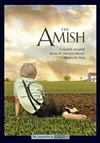Q: How many Amish live in North America?
A: Approximately 342,100 adults and children. In most communities, over half of the population are children and unbaptized teens. Thus, the number of baptized adult church members is likely about 154,000.
Q: Where do they live?
A: They live in 31 states, the Canadian provinces of Manitoba, New Brunswick, Ontario, and Prince Edward Island, and the South American countries of Argentina and Bolivia. Nearly two-thirds (62 percent) live in three states: Ohio, Pennsylvania, and Indiana. See Amish Population 2019 for a complete listing. There are about 2,540 local congregations, which are called church districts. Each district typically includes between 20 and 40 families. A settlement is a geographical area that contains one or more districts. Large settlements have more than 100 districts. There are 568 different Amish settlements, but many of them have only one or a few districts.
Q: Are the Amish a cult?
A: No, they are a Christian church that accepts the basic tenets of Christian faith. Unlike a cult, they do not have one authoritarian leader who demands unquestioning obedience of all Amish people. They are free to join and leave the Amish community at their will. Members are expected to obey the teachings of the New Testament and the regulations established by the adult members of their local congregation.
Q: When did the Amish begin?
A: They trace their roots to the Anabaptist movement in Switzerland in 1525 at the time of the Protestant Reformation. The Anabaptists emphasized voluntary adult baptism and a church that was free from state control. Because most had been baptized as infants, they were nicknamed rebaptizers or Anabaptists. The Amish were part of this movement until 1693 when they formed their own group in Switzerland and the Alsatian region of present-day France. Their first leader was Jakob Ammann; hence, they became known as Amish. See Amish Origins for more information.
Q: Is the Amish population growing?
A: Yes. The population has doubled over the past 20 years due to sizable families (five or more children on average) and high retention rates (on average about 85 percent of Amish youth eventually join the church).
Q: When are Amish youth baptized?
A: Typically between the ages of 18 and 21. As Anabaptists, the Amish church emphasizes the importance of making a voluntary adult decision to become a Christian and join the church. See Religious Rituals for more information.
Q: What is Rumspringa?
A: Rumspringa means “running around” in the Pennsylvania German dialect. It is the time, beginning at about age 16, when youth socialize with their friends on weekends. Rumspringa ends with marriage. (For those who don’t marry, Rumspringa ends in their mid to late twenties.) This period is an important time when Amish youth need to decide if they will be baptized and join the church or leave the Amish community.
Q: Where do Amish youth go to school?
A: About 90 percent attend one- or two-room private Amish schools; the others go to rural public schools. In Amish schools, an Amish teacher is typically responsible to teach all eight grades, or in the case of a two-room school, half of the grades. Amish children typically end their formal schooling at the end of eighth grade. See Education for more information.
Q: What language do the Amish speak?
A: Regardless of where they live, the Amish speak the Pennsylvania German dialect (popularly known as Pennsylvania Dutch), except in a few communities where they speak a Swiss dialect. English, typically learned in school, is their second language. Most Amish are fluent in both English and the dialect, but very few can speak standard German. Some learn to read old German script so they can read their religious books and publications. Amish people often refer to non-Amish as “English,” because they speak the English language. See Language for more information.
Q: Are there different kinds of Amish?
A: Yes. There are many different affiliations of Amish, each of which has its own dress styles, carriages, occupations, and rules about technology. The enormous cultural diversity among Amish groups and church districts makes it risky to generalize about “the” Amish. See Diversity for more information.
Q: Do the different groups have anything in common?
A: Yes, most Amish groups share certain practices: use of horse and buggy for local transportation, rejection of electricity from public utility lines, prohibition against televisions and computers, some type of distinctive dress, beards for men, ending of formal education at the eighth grade, meeting in homes for worship every other Sunday, lay religious leaders, and living in rural areas.
Q: Are all Amish farmers?
A: No. In the past most families farmed, but now many Amish earn their living from various types of Amish-owned establishments—small shops, businesses, carpentry, construction, retail stores, roadside stands—as well as employment in “English-owned” factories, restaurants, and shops. See Occupations for more information.
Q: Do the Amish reject all modern technology?
A: No. They selectively use technology—choosing the types that serve their community rather than debilitate it. The rules for what is accepted are largely determined by the local church, so there is a wide variation on what is permitted. In general, the Amish accept some new technology such as chain saws and inline skates, and reject computers and television. Most groups modify technology to fit their cultural values. Some, for example, place steel wheels on tractors and put electric turn signals on their carriages. See Technology for more information.
Q: Why do the Amish drive horse and buggy?
A: The Amish think that ownership of cars would encourage people to drive away from home more often and give youth easier access to cities. In short, they fear that the car would pull their community apart. The horse and buggy is also a symbol of their separation from the larger world. Many Amish groups permit their members to hire “taxis” driven by local non-Amish people who provide their own vehicles for business and long distance trips. With the exception of air travel, the Amish are permitted to use public transportation—buses, boats, and trains.
Q: Do the Amish pay taxes?
A: Yes. They pay all the taxes—income, property, sales, estate, corporate, school—that other people do. In fact many of them pay school taxes twice—for both public and private Amish schools. The US Congress exempted the Amish from participating in Social Security in 1965 because the Amish viewed it as a form of commercial insurance, which they opposed. They believe that members of the church should care for each others’ physical and material needs. Thus, most of them do not pay into Social Security or receive payments from it. In some states, the Amish have also been exempted from workers compensation (insurance for on-the-job injuries) for the same reason. See Government for more information.
Q: Do the Amish use modern medicine?
A: It all depends. Many Amish use modern medicine and the services of doctors and hospitals, and many prefer going to chiropractors. Members of some of the more traditional communities prefer homeopathic or alternative forms of medical treatment. In general, the Amish are less likely to select high risk or expensive medical interventions than members of mainstream society. There are no explicit religious prohibitions against certain types of medicine. The use of modern medicine varies greatly from family to family and group to group. See Health for more information.
Q: Do the Amish have genetic disorders because of inbreeding?
A: There are some diseases that appear more frequently in some Amish communities because their gene pool is restricted. For the same reason, other diseases are less likely to present themselves. The Amish do not permit first cousins to marry but sometimes second or third cousins marry.
Q: May outsiders join the Amish?
A: Yes. Although the Amish do not actively evangelize, several dozen outside people have joined the Amish. Potential members must be willing to learn the dialect and accept the rules of the church in order to be baptized and become members of the church. Some outsiders have become well accepted and respected members of the Amish community.
Q: What is shunning?
A: If members break their vows of baptism by disobeying the regulations of the church or the authority of its leaders and refuse to confess their error, they will face excommunication. The church, using several biblical scriptures, teaches that members should shun ex-members to remind them of their disobedience in hopes of winning them back. Different Amish affiliations practice different types of shunning and the mode varies by family and church. Shunning is not the end of social interaction, but involves rituals of shaming, such as not eating at the same table with someone who has been dismissed from the church. Wayward members can always return and be reinstated if they confess. People who leave the Amish but were never baptized are not excommunicated or shunned, because they never made baptismal vows. See Church Discipline for more information.
Q: Do the Amish have problems?
A: Yes. They are humans and, like all human societies, have their share of problems. Sometimes rebellious youth act out and abuse alcohol or use drugs. Some marriages turn sour. There are documented cases of incest and sexual abuse in some families. Although such problems do exist, there are no systematic studies to enable comparisons with other groups or mainstream society. In general, the Amish way of life provides many sources of satisfaction for most of its members.



